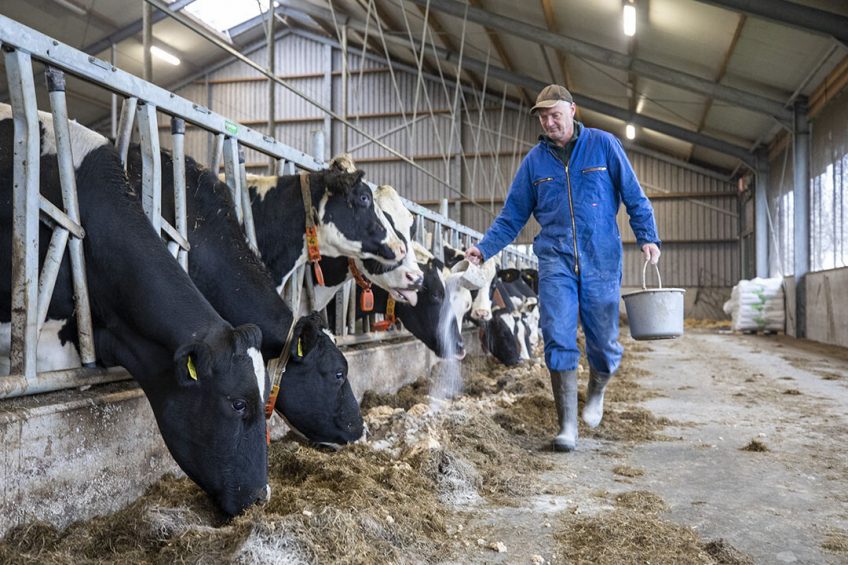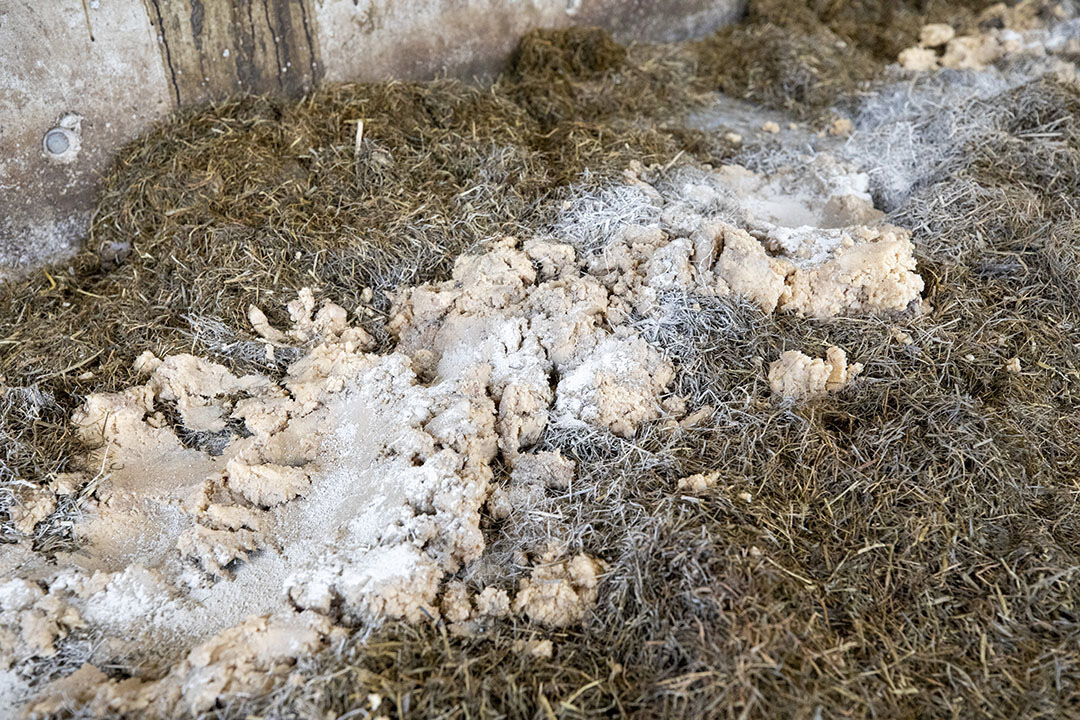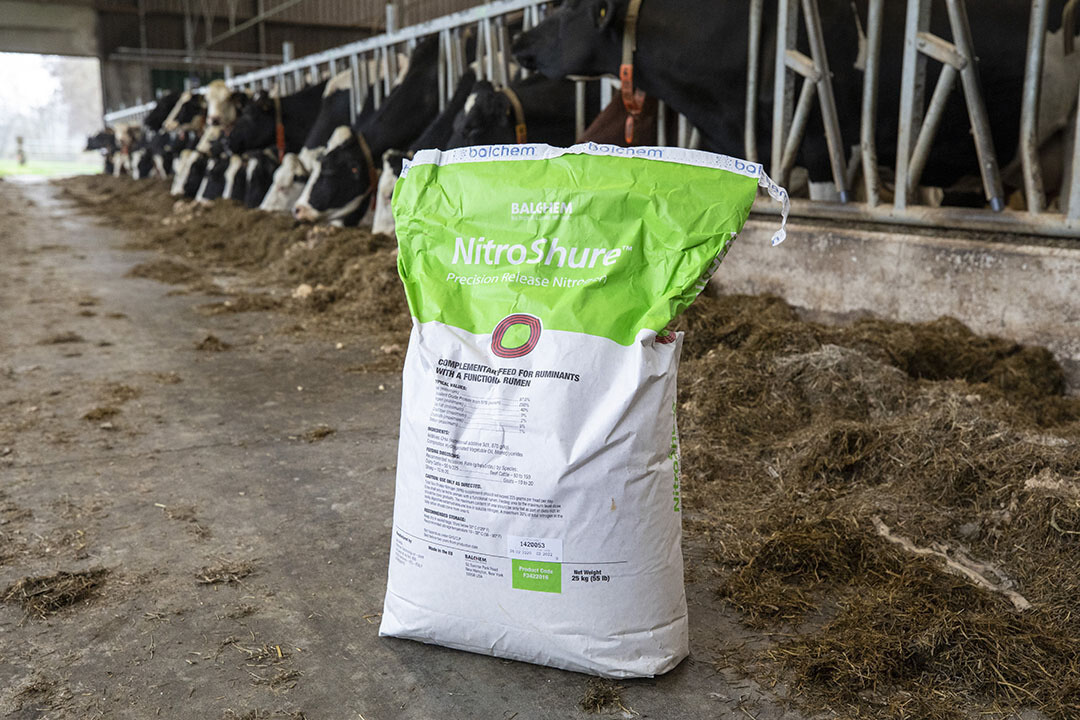Influencing rumen microbes improves nitrogen efficiency

Feed additives can increase nitrogen efficiency and reduce ammonia emissions. Proper rumen functioning, the right protein-energy balance in the rumen and more intestinal digestible protein also help.
Experts agree that improving nitrogen utilisation at dairy farms requires a comprehensive approach. Dairy farmers can reduce ammonia emissions by taking several measures. In addition to optimising dairy rations, improvements in roughage crops, rearing youngstock and transition management are all options. Feed additives still play a limited role, but more independent research may change this view.
What causes high nitrogen excretion?
Jan Dijksta, senior cattle feed lecturer at Wageningen University & Research, explains that when too much protein is digested in the rumen, nitrogen excretion will also be too high. Secondly, when there is too little energy in the cows’ rations, the conversion of amino acids into milk protein will be suboptimal and nitrogen will disappear into the urine. “On average, 75% of the ration consists of roughage. Good quality roughage that provides a lot of energy is the basis for successfully cutting nitrogen emissions. The final steps in this process can be additives,” says Dijkstra, who points out that relatively limited independent research has been done on the effects of additives on dairy farming. Dijkstra divides the additives into seven groups (see Table 1).
Different measures affect nitrogen emissions
Wilfried van Straalen, researcher at Schothorst Feed Research, says there are various measures that affect nitrogen emissions (Table 2). “Additives can contribute to this, but don’t expect any miracles,” he says. “However, a recently published meta-analysis shows that tannins do have a positive effect on nitrogen use.”
He emphasises that the results of additive enhancement are strongly dependent on the type of ration and the quality of roughage and concentrates. “Adding slow-release urea and rumen bypass amino acids is only useful when the ration calculation shows that there is a shortage, and that this is the first limiting nutrient.”

Limited number of feed additives
Feed additives that are supplied directly to cattle farmers to improve nitrogen efficiency have limited availability. Agrinutrition is a Barents subsidiary, which is a wholesaler in raw materials. Its consultants directly supply products to dairy farmers. “We decide on the composition ourselves because we have extensive knowledge of raw materials,” says Agrinutrition category director Bianca Meijerink. “We‘ve been developing feed additives for years based on market needs and practical research. Our motto is: “Farmers are the scientists. They prove that our products work and keep them on the market.”
Additives for meeting environmental demands
According to Jan Speerstra, owner of Speerstra Feed Ingredients, additives can help to meet ever-stricter environmental demands. They can also help to achieve a better return on investment. “We keep speaking of ‘additives’, when in fact, they are just additional animal feed. When you use the rumen bypass amino acids lysine and methionine, more methionine and lysine are made available to the cow at the gut level. This improves nitrogen efficiency and reduces nitrogen excretion. Dairy farmers can thus feed less protein without compromising on milk or protein levels.”
Speerstra is very positive about feeding rumen bypass amino and fatty acids to dairy cows. “In pig and poultry farming, synthetic amino acids in feed are already used with considerable success. Feeding cows based on which specific amino and fatty acids they need concentrates the ration, improves nitrogen efficiency, reduces methane emissions and contributes to more well-balanced milk fat. We‘re not yet ready for this in the Netherlands. In the United States, however, they‘ve been working with this system for some time.”

Feed additive prices
Feed additives are not cheap. Prices vary from € 125 to € 500 per 100 kilogrammes. “You can’t compare these prices with those of regular feed,” says Eric Heemskerk, director at Ingenieursbureau Heemskerk. “They‘re used in very small quantities and they can save considerably on other expensive sources of protein, such as soy or rapeseed.”
“By properly feeding a cow, you actually feed the rumen bacteria,” says John Vonk, product developer at Ingenieursbureau Heemskerk. The company sells a slow releasing rumen nitrogen in the Netherlands, Belgium, and Germany. “By keeping the amount of urea in the rumen constant and minimal, you synchronise the protein and carbohydrate supply, which makes rumen bacteria grow better. This applies particularly to the bacteria that break down cellular walls, so that the cow digests the ration better. If there is enough available energy, the cow makes better use of the feed protein.”
The minimal dosage of 100 grammes per cow per day can replace 600 to 1,000 grammes of protein-rich feed, such as soy or rapeseed meal, and it reduces nitrogen excretion by at least 2.5%.
Controlling rumen processes
“Controlling rumen processes is crucial for proper protein use,” says Speerstra. “The rumen is responsible for about 70% of a cow’s protein supply. The composition of a microbial protein which is formed in the rumen is the most suitable for a cow to convert into milk protein. Essential oils inhibit the activity of hyper ammonia producing (HAP) bacteria and the digestion of protein in the rumen. This increases protein use and reduces ammonia emissions.”
Additional energy at the gut level
Rumen bypass fats yield additional energy at the gut level and maintain the energy-protein balance in the ration. “This improves protein use,” says Robert Meijer, marketing and communication manager, ruminants at ForFarmers. He emphasises that a protein surplus in the cow’s rumen, especially from that derived fresh grass and grass silage, represents the biggest nitrogen loss. “A proper rumen function and a proper coordination of energy and protein in the rumen is the main priority for high nitrogen use. Make sure you have a proper combination of roughage, by-products and additional concentrates, so that the total ration fits the cows’ needs and protein from roughage and regular feed is optimally used.” Meijer also thinks that it’s wise to feed additional forage maize in rations that are rich in grass and that feed additives may contribute to improving nitrogen use.
ForFarmers sees practical potential for its scientific research on additives. Meijer does not want to say which ones. “We test the effect of additives under Dutch circumstances,” he says. “Specific buffers, yeasts and B vitamins can further improve rumen fermentation, because they stimulate bacteria that break down cell walls. These bacteria in particular capture much of the protein surplus from grass silage and thus considerably improve protein use.”











